
Engelmann, Proceedings of the American Academy of Arts and Sciences 3: 292, 1856 [1857]
Herbarium; Herbarium; Herbarium; Herbarium; Herbarium; Herbarium; Herbarium; Herbarium; Herbarium; Herbarium; Herbarium; Herbarium; Herbarium; Herbarium; Herbarium (as O. violaceae macrocentra); Herbarium (as O. violaceae macrocentra); Herbarium (O. macrocentra minor); Herbarium (O. macrocentra minor); Herbarium (O. macrocentra minor)
Original Description
What is Opuntia macrocentra?
Opuntia macrocentra is a much-grown and much-enjoyed prickly pear cactus found in western gardens. It is related to O. azurea. The flowers are attractive and the pads are often bluish or purplish.
Details
From Powell and Weedin:
O. macrocentra plants are spreading to upright plants, 30-60 cm tall or taller. Cladodes are obovate to orbicular, 10-20 × 10-20 cm, or the pads are slightly wider than long. Spines may be produced on the upper one-fourth of the pad or only in the areoles of the upper edge. Occasionally, plants may be essentially spineless. The largest spines are often directed upwards. Spines are black to reddish-brown and 5-10 cm long.
Flowers have sharply defined, bright red centers that may be star-shaped. They are 6-8 cm long and 5.5-8 cm wide. The filaments are about 1.5 cm, pale green proximally and cream-colored distally. Anthers are yellow. The style is cream-colored and 1.7-2 cm long. The stigma lobes are cream-colored or pale green. The reddish fruit is oboviod, ovoid, or ellipsoid, 3-4.3 cm long, 1.5-3 cm in diameter, and deeply concave. The rind is purple and the juice and pulp are pale-purple to clear. Seeds are flattened, tan, 3.4-4.5 mm in diameter, 1.5-1.9 mm thick with a broad notch on one side and prominent raphae.
O. macrocentra is tetraploid
O. macrocentra minor has been described by Powell and Weedin, and it is diploid.
Other Notes
O. macrocentra has been confused with O. chlorotica santa-rita and O. azurea, but the three cacti are distinct. It is unfortunate that O. macrocentra was sometimes mislabeled as a prickly pear variety of O. violaceae because O. violaceae is a nonexistent species.
Britton and Rose reported that specimens with bluish pads can be especially showy.
O. macrocentra is an excellent garden plant in many climates. Its striking color and beautiful flowers are impressive. It is easy to grow in USDA climate zone 7 and warmer if the climate is not to wet. Plants can become large in gardens and without drought stress may not reach their best stress-caused color.

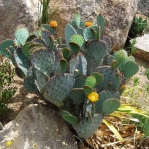
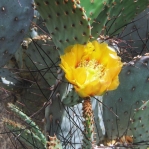
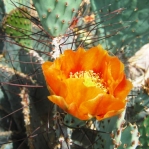
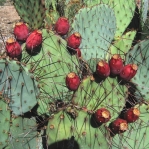
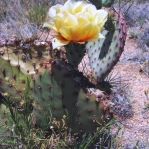
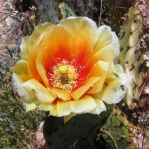
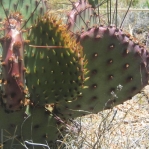
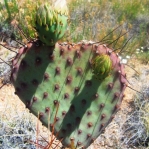
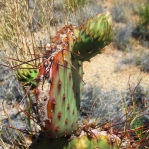
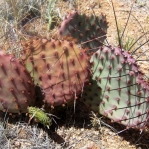
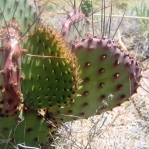
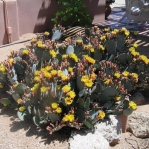
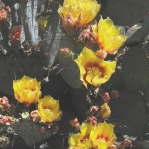
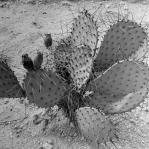
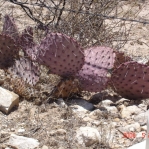
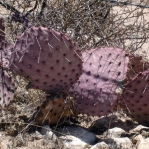
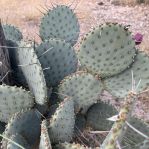
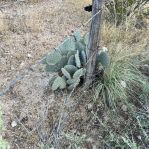
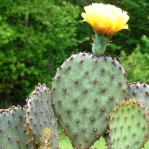
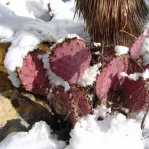
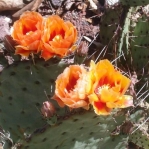
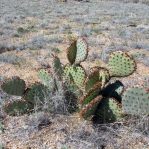
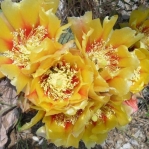
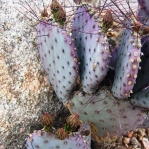
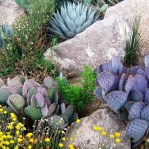
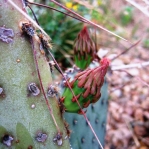
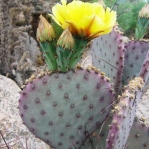
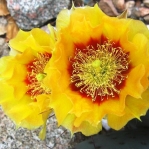
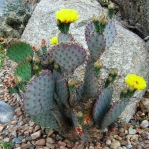
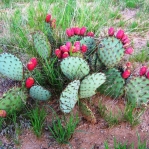
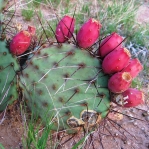
What USDA climate zone?
Hi,
Thanks for visiting the Website. O. macrocentra is surprisingly hardy in desert or semi-desert areas. One survives at 7,000 ft in Santa Fe, New Mexico. That one has taken -10F. It grows partially under a tree and so may have gotten some protection. Normally the plant comes from the southern part of New Mexico and Texas.
Generally, desert Opuntias are not as hardy in humid/wet climates as they are in dry climates. It helps to plant them against a wall the reflects winter heat/sun. It helps them to be next to a structure that might give off some warmth. It helps them to have very good soil drainage.
Joe
Hi,
The climate zones refer to the USDA plant hardiness zones.
https://planthardiness.ars.usda.gov/PHZMWeb/
You can put your zip code in and find you your zone. The zones are divided by temperature and generally report the lowest temperature you can expect in any given winter. This helps you determine what to plant. Many cacti grow in zone 8, very few grow in zone 4 where winters are cold.
Joe Shaw
Hi Joe,
I have an Opuntia that is labeled macrocentra (var.aureispina). It is not blue. I see iNat and POWO both accept the name aureispina, but you don’t. Is that name a synonym of macrocentra or is it a valid name? Since you guys are the experts I’d like to use the correct name.